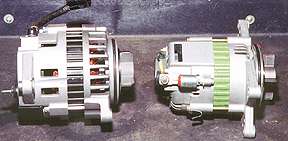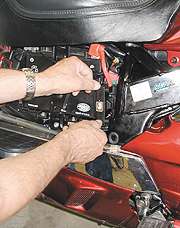 












|


If you've been following Wing World's series
on electricity, you're no doubt aware that the factory-supplied GL1500 alternator has limitations when it comes to supplying the electric current necessary to power the many
popular electrical accessories found on many of our bikes. Some of us attempt to overcome this problem by shutting down the unnecessary accessories while in
slow-moving traffic, but others are seemingly unaware that the current supply isn't limitless. Some Wingers equip their bikes with voltmeters, then they continue to ride as if
nothing were wrong even though their new peace-of-mind device clearly shows problems.
We've explored the reasons why batteries fail, and we've seen that the key to a long
and happy battery life is in keeping it charged properly. That includes on the road as well as in the garage. By keeping the bike hooked to a battery maintainer at home, we avoid
the ravages of self-discharge and parasitic current draw that result from long periods of non-use. How about out on the road? We know from reading the electricity series in
the past several issues of Wing World that the battery of an absolutely stock GL1500 will be subjected to around 10 amps discharge rate any time the bike is stopped with the
brakes applied. Add electrical accessories, and the story gets worse. Since you can draw current from your battery at a faster rate than your voltage regulator will allow it
to go back in, you must ride several hours at highway speed to put back all of the battery capacity lost during one half hour of in-town riding or drill team practice. This constant
draining and charging of the battery takes its toll by causing active material to slough off of the battery plates and fall to the bottom of the battery case. Eventually, this
sloughed-off material will touch the bottom of two or more plates and cause them to short circuit. That's the end of the battery. So it would seem that we could avoid this problem
by preventing the battery from ever discharging, even while stopped with the brakes applied. Can we do that with the stock alternator? No, we can't, because the
stock alternator generates only about 20 amps at idle speed, and that's not enough. 
Compufire alternator (left) compared with OEM unit. A Solution
Enter Engine Electronics, Inc. with their Compufire 90 amp alternator for GL1500 Gold Wings. The alternator may be purchased in combination with a sealed, maintenance-free
battery of the absorbed glass mat (AGM) type for $499 or by itself for $429. Since that amounts to purchasing a $100 battery for $70, I highly recommend it unless your
current battery is virtually new. The AGM battery has many benefits, not the least of which is eliminating the need to ever check acid level again. Engine Electronics insists
that only an AGM battery should be used due to the higher voltage (15 volts) seen by the system in cold weather. I disagree, because the maximum voltage of the Compufire is well
within the limits set for the OEM alternator (15.5 volts), and also because the cold battery that will be temporarily exposed to this voltage will not be adversely affected by it.
The Compufire 90 amp alternator is an adaptation of a late-model automobile alternator. The original manufacturer has created a new end frame and drive coupling
to meet Compufire's specifications, and the entire product is very robust and professional looking. Although the plug on the back of the alternator doesn't match the bike's original, a
pigtail is provided with the correct plugs for both the alternator and the original field wire plug. This pigtail actually makes installation easier than it would otherwise be due to the
extra length of wire provided. Installation instructions are complete and fairly straightforward, though I found it necessary to remove the left passenger footrest and its
chromed plastic shroud in addition to the two recommended left side covers. I also found it helpful to release the clamp holding the thick black wire to the frame. This provided the
slack needed to easily attach the wire to the output stud on the new alternator. Performance
One claim made for the product is that it is
temperature compensating, meaning that the regulated voltage is higher in cold temperatures than in hot. That's a benefit, because a slightly higher voltage is necessary
to fully charge a battery in cold weather. Actually, many excited-field alternator regulators like this one are temperature compensated, though it makes more sense
to do so when the regulator is mounted where it'll experience the same temperatures as the battery and not necessarily those of the alternator itself. Since this alternator is
actually mounted to the engine block rather than hanging on a bracket as in your car, the entire alternator (including the integral regulator) is quickly brought to near engine
temperature. Therefore, the advantage of regulating the voltage to suit battery temperature is somewhat negated. After fifteen minutes of engine operation, the
regulated voltage will be reduced slightly due to engine temperature even though the battery may still be quite cold. Even so, I don't view this as a problem.
After installation, I proceeded to test the Compufire for voltage regulation and current output. The ambient air temperature during the test was 96 degrees Fahrenheit.
Immediately after engine start, the system voltage was being regulated at 14.52 volts at 800 engine rpm. After fifteen minutes of warm-up, the voltage had stabilized at 14.02
volts. Total current output available at this engine speed was 50 amps, which is more than sufficient to prevent battery discharge even with the brakes applied and cooling fans
running or while operating the motorcycle in reverse. Some riders rev the engine while using reverse to keep the battery voltage from dropping. That's no longer necessary.
Your reverse system has a voltage-limiting feature that this alternator activates even at idle speed, and you'll immediately notice improved reverse operation performance.  To test the full output of the Compufire, I applied a 125-amp
load across the battery terminals and noted total output of 85 amps. When I add in amp draw from the ignition and alternator field current that I couldn't measure without the engine
running, I'm satisfied that the alternator is performing up to its claimed output specs. Bear in mind the fact that production of large amounts of electrical current takes engine
power, and the extra power required at high electrical demand levels will increase your fuel consumption. There is no free lunch! That's the down side; the up side is that you're far
less likely to get stuck with a dead battery in the middle of Nowhere, U.S.A. If your machine is in stock trim or has only 15 to 20 amps of extra electrical accessories, you'll
likely notice no change in fuel mileage. To test the full output of the Compufire, I applied a 125-amp
load across the battery terminals and noted total output of 85 amps. When I add in amp draw from the ignition and alternator field current that I couldn't measure without the engine
running, I'm satisfied that the alternator is performing up to its claimed output specs. Bear in mind the fact that production of large amounts of electrical current takes engine
power, and the extra power required at high electrical demand levels will increase your fuel consumption. There is no free lunch! That's the down side; the up side is that you're far
less likely to get stuck with a dead battery in the middle of Nowhere, U.S.A. If your machine is in stock trim or has only 15 to 20 amps of extra electrical accessories, you'll
likely notice no change in fuel mileage.
Engine Electronics equips their alternator kit with two 55-amp fuses to replace the OEM single 55-amp fuse. Firstly, there's no
evidence to suggest that this combination will protect the circuit at 110 amps or if the combination of the two fuses stacked on one another might have a synergistic effect.
Secondly, I have a problem with decreasing the circuit protection designed by the manufacturer by such a large amount without increasing the wiring gauge in the circuit.
Lastly, I've determined through testing that a maximum of 70 amps will pass through that main fuse (in my particular bike) even with the Compufire alternator running at full
output. Therefore, I recommend that circuit protection be limited to 80 amps maximum. I've installed a 70-amp fuse in my fuse holder and have been unable to blow that fuse in all
of my testing. The fusible link shown in the accompanying photos is sold in auto parts stores and screws right onto the original fuse terminals. The only modification necessary is
to cut an opening in the plastic fuse cover with an X-acto® knife to allow the face of the device to protrude. The Buss part number for this part is BP/FLP-80 (or –70 for
the 70-amp version). NAPA sells the same product under their part number 782-2042 (80 amp) or 782-2041 (70 amp). The same product is also sold in Autozone stores under the Littlefuse brand.
Although long-term reliability is as yet unknown, I see no reason to harbor doubts based on the design and obvious quality of this product. Whether you need more power
for your electrical toys or simply want to replace a fried OEM alternator, I give the Compufire alternator a "thumbs up." For more information, contact Engine Electronics, Inc.,
196 University Parkway, Pomona, California 91768. (909) 598-5485; fax (909) 598-5695. http://www.compufire.com/
.
—Stu Oltman
PREVIOUS PAGE  NEXT PAGE NEXT PAGE |
|